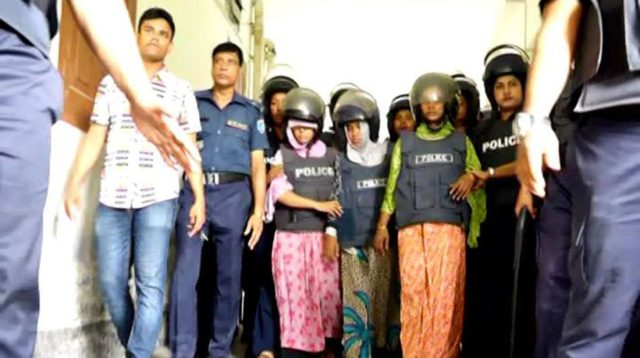By: November 17, 2018



Bangladesh’s most lethal home-grown militant organization, Jamaat-ul-Mujahideen Bangladesh (JMB)—which has multiple ideological and operational factions, including the Islamic State (IS)-inspired neo-JMB and al-Qaeda linked core Jamaat-ul-Mujahideen (JM)—has gained notoriety over the last few years for recruiting and nurturing a network of women militants. Despite robust counter-terrorism operations following the July 2016 Holey Artisan Bakery attacks in the capital Dhaka, an alarming number of women are taking up the cause of militancy. The intermittent arrests and events involving JMB’s women operatives across the country and beyond in the last couple of years have become a major headache for Bangladesh’s security establishment.
Two cases in 2018 involving JMB’s female operatives made national and international headlines. In February 2018, two sisters linked to the neo-JMB faction and inspired by the IS’s jihadist ideals were arrested and charged for carrying out separate knife attacks in both Melbourne, Australia and in Dhaka. On February 9, Momena Shoma, a Bangladeshi student enrolled to study linguistics at La Trobe University stabbed her homestay’s landlord Roger Singaravelu in the neck to fulfil a moral obligation to the Islamic State’s call for jihad (Sunday Morning Herald, February 14; Prothom Alo [Dhaka], September 21). Her sister, Asmaul Husna, carried out a similar knife attack targeting Dhaka Police’s Assistant Commissioner Tohidul Islam on February 12 when the local police officials were enquiring about the Melbourne incident and possible JMB-IS links (Daily Star, February 14). Both sisters were in their early twenties and admitted to their neo-JMB links and IS inspiration during the following investigations.
In Bangladesh, myriad militant extremist groups such as the JMB, Ansar al-Islam (formerly Ansarullah Bangla Team) and Hizbut Tahirir-Bangladesh (HT-B) have been engaging women operatives mostly for religious teaching and as supporting members like couriers and informants. A new trend has been emerging since mid-2016, where women operatives are found to be carrying out violent combat operations. One media estimate suggested that by December 2016, Bangladesh police had arrested at least 20 women militants from different groups including JMB, with evidence of a possible all-women suicide team (The Independent, December 25, 2016).
Evidently, JMB is a pioneer in engaging women for jihadist activities that include suicide missions in addition to supporting tasks. They even trained the women cadres to use hand grenades and knives. Between July and September 2016, Bangladeshi authorities arrested around 12 women JMB operatives. [1] In early September 2016, the detective branch of the Bangladesh police arrested four female members of JMB belonging to a suicide group from the Kazipur area of Sirajganj district. They were arrested in the house of senior JMB leader, Faridul Islam, while holding a meeting to discuss the recruitment of new women cadres to carry out violent attacks (Poriborton News, September 5, 2016).
After two months investigating the suicide bombing conspiracy, Bangladesh police encountered an actual female suicide bomber for the first time. In late December 2016, Shakira, a female neo-JMB member detonated her suicide vest during a search and sweep operation in a JMB safe house located in the Ashkona area of Dhaka while feigning surrender (BanglaNews24.com, December 24, 2016). During this police raid—code-named Operation Ripple 24—the Dhaka Metropolitan Police’s Counter-Terrorism and Transnational Crime (CTTC) department arrested two other female neo-JMB jihadists. Not surprisingly, Shakira had been radicalized by her husband, fugitive neo-JMB militant Rashid-ur Rahman Sumon. Like Shakira, most of JMB’s women members who were arrested were found to be closely related to the JMB’s leadership (Bangladesh News 24, December 27, 2016).
Until April 2018, the counter-terrorism unit, Dhaka Metropolitan Police (DMP), had little to no information on the top leaders of the women’s wing of the neo_JMB. With the arrest of Humaira Jakir Nanvi on April 5, the police unearthed the working of the women wing—or “Bat Women” squad—as they were called. Humaira was arrested for her involvement in a foiled suicide attack on August 2017, targeting a National Mourning Day program in Dhanmondi (Bangladesh News 24, August 15, 2017; Daily Star, April 5). The investigations into the foiled suicide attack revealed Humaira as the chief financier of the neo-JMB. She was also in charge of recruiting new women into the rank and file of the group.
Interestingly, in October this year, two neo-JMB operatives identified as Khadija Akhtar Meghna and Israt Jahan—accused in the Holey Artisan Bakery attack case—surrendered after a raid on their hideout in Madhabdi area in Narsingdi district (New Nation, October 18). The irony is that these two female operatives had been arrested earlier, in mid-2016, under suspicion of being involved in militant activities, but were later released as the investigating agency could not establish their militant links.
Like Khadija and Israt, many others were released from custody earlier without any charges. Later, the police found that several female operatives who had been released were becoming involved in these subversive activities. Cases such as this demonstrate law enforcement agencies’ lenient attitude toward female suspects, which is commonly exploited by the JMB.
Interrogations with several women operatives suggested that they nurture a specific anger against the Bangladeshi security forces. One of the apprehended militants, Aklima Rahman, confessed to having been trained to target Bangladeshi police and the elite Rapid Action Battalion. During the training, she learned how the security agencies arrested jihadists and tortured their male counterparts in custody and how to avenge those acts.
It is not clear, however, whether the women cadres are pressured into following their husbands, lovers and brothers already waging jihad in the country and beyond, or if they are voluntarily attracted to Islamist ideals. While the police versions depict a narrative of coercion and forced recruitment, the February 2018 knife attacks involving sibling sisters illustrated a different picture of individual motivation, without material assistance or moral push from the neo-JMB.
It is also found that neo-JMB recruited women from beyond their established family networks. The group focused on recruiting those with moderate educational background and who belonged to elite schools and universities. For example, the three female members of the neo-JMB— Aklima Rahman Moni, Khadija Parveen Megna, and Ishrat Jahan—who were arrested on August 15, 2016, were students of Manarat International University in Dhaka. Khadija Akhtar and Ishrat Jahan were arrested again in October this year from Madhabdi in Narsingdi district. Another member arrested around the same time was Istishna Afroz Oishee, an intern at Dhaka Medical College Hospital. Similarly, the sisters involved in the knife attacks in February this year are also well educated and belong to affluent families of Bangladesh. The chief financier and recruiter of the neo-JMB, Humaira Jakir Nanvi, was an alumnus of the North South University (NSU) and had been educated in Malaysia as well (Daily-Sun, April 9).
Unlike the old, core JMB, the neo-JMB faction went a step further in recruiting female militants by romanticizing the concepts of jihad, foreign fighters and martyrdom. The new wave of recruitment and indoctrination of female militants into the fold materialized virtually through the use of various social media platforms such as Facebook, WhatsApp and other encrypted social media applications like Threema and Telegram (Daily Star, August 20, 2016).
While the participation of women in militant violence in the subcontinent (Indian Kashmir and Sri Lanka) is not completely unusual, Bangladesh began witnessing this trend in 2004 when the JMB core established a dedicated women’s branch. This so-called “sister branch”—under the guidance of the wives of the top leaders of JMB—was mostly responsible for daawa activities (proselytization) and religious teachings. Between February and April 2009, security officials in Bangladesh arrested nearly 25 suspected JMB female militants who were later released from custody without any charges. These women arrestees never admitted to being a part of the JMB but were family members and relatives of JMB’s male operatives (Daily Star, February 21, 2009; Indian Express, April 23, 2009). Bangladeshi agencies, however, admitted that prior to these arrests, they did not have any evidence that JMB had a woman wing or trained female members.
Certainly, the traditional women’s roles in Islamic militancy in the country have evolved dangerously over the last few years. Young girls have joined the rank and file of jihadist organizations and have redefined their role in groups like the neo-JMB. With effective female combat units along the lines of al-Qaeda inspired jihadist sisterhood or Islamic State’s “jihadist brides” (or for that matter Al-Khansaa brigade), the increasing trend of female participation in militancy or Islamic jihad in Bangladesh is likely to take a novel turn in the coming years.
NOTES
[1] Author’s estimation based on local media reports.
